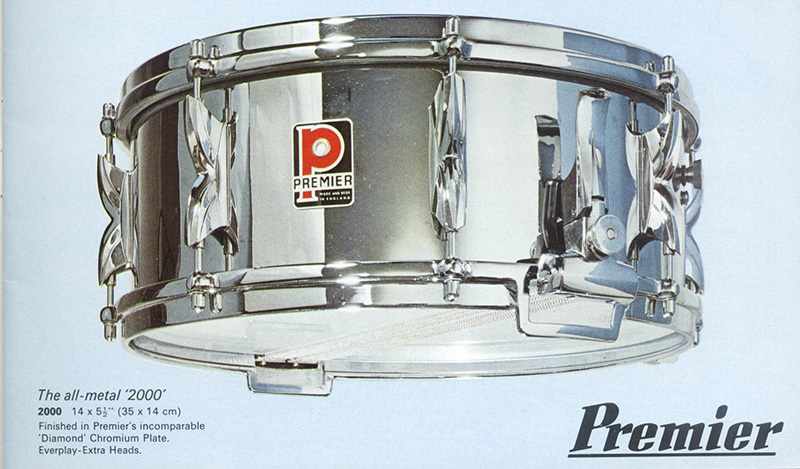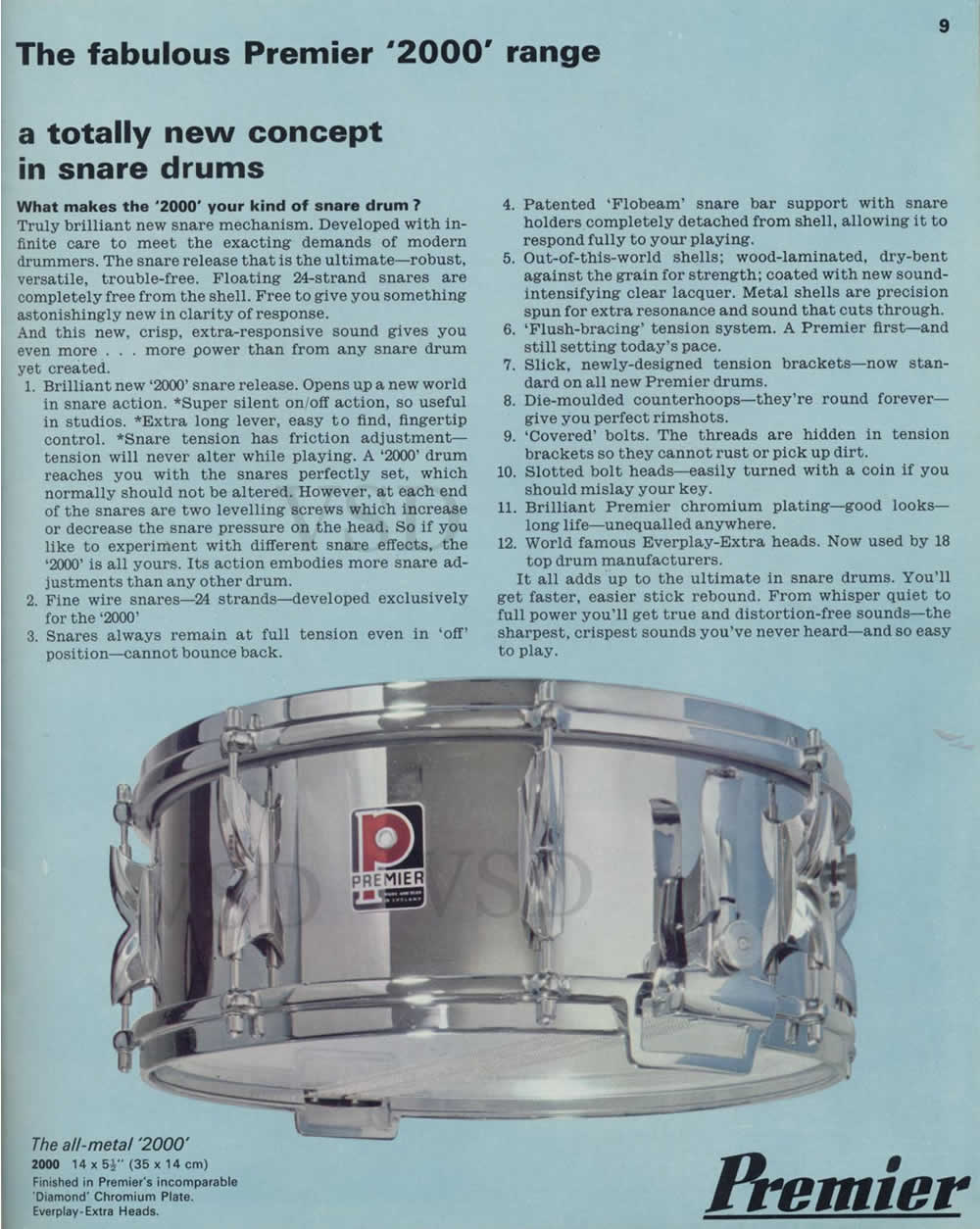You are using an out of date browser. It may not display this or other websites correctly.
You should upgrade or use an alternative browser.
You should upgrade or use an alternative browser.
What exactly is the purpose of having snare beds????
- Thread starter johnwesley
- Start date
Andy
Honorary Member
I've never liked a bed that extends beyond the tension rod point either side of the wires.Okay I'm curious. I know a snare bed can be too shallow or not wide enough, or both. What happens if the bed is too deep or wide? Anything?
SupraColour LLC
New Member
I see it this way, there are basically two types of snare strainer systems. One being the parallel system and the other having straps and a conventional throw and butt. Ludwig and Premier both made parallel systems. Ludwig called theirs the super sensitive and Premier made the 2000 model. Both are made of aluminum and both were made to compete with one another. Personally speaking, I like Ludwig's design better. I dissected both and the SS is by far a simple design. Both Ludwig and Premier wires float on the surface freeing up tension, making for a more resonate head and not a choked one like the conventional ones (the strapped ones) tend to do. The reason for the snare beds is the same as say pouring a foundation for a home. It's a place for the wires to "dig into".I see from time to time custom drum makers making a point of cutting wider beds to accommodate wider snare wires like 42 strand. What I don't understand is why? Not even clear on why snare beds are needed except maybe for those super sensitive Ludwigs, or Pearl free floaters that allow the snare wires to extend beyond the rim of the shell. As I look at my snare drums, the wires and the plates they're soldered to are a 1/4 inch from the outside of the shell and lay perfectly flat. So what's the purpose of snare beds?
Larry
"Uncle Larry"
Those are THE most badass lugs I have ever seen. They even beat the Sonor teardrop. Wow. I'm surprised they didn't take off. This is the first time I ever saw them. I want one of those, but it probably won't happen.I loved the Premier 2000 snare drum, and wanted one desperately back in the late 70s. I was only put off by those slotted tension rods. The strainer seemed to work great, and those drums sounded really nice.


Larry
"Uncle Larry"
What if it's an 8 lug snare drum?I've never liked a bed that extends beyond the tension rod point either side of the wires.
SupraColour LLC
New Member
i have one for sale .......great shape
Ghostin one
Senior Member
Neat idea - the entire snare side bearing edge is curved.
(There's a diagram at 1:38)
(There's a diagram at 1:38)
Andy
Honorary Member
Same principal Larry. As soon as the snare bed extends beyond the lug's influence, it degreases the ability to tension the head evenly. In other words, instead of a localised slackening of the head near the bearing edge, an overall unevenness is created that extends further in towards the centre of the head. I find that creates additional tuning challenges & reduced options, but that's just my experience, others will disagree.What if it's an 8 lug snare drum?
Morrisman
Platinum Member
The Rogers Dynasonic was a simpler version of this - a self contained frame with tension adjustment for the snares - which was held in place by a conventional strainer. No snare beds, so if you don’t use the frame it gets rattly unless it’s extra tight.I see it this way, there are basically two types of snare strainer systems. One being the parallel system and the other having straps and a conventional throw and butt. Ludwig and Premier both made parallel systems. Ludwig called theirs the super sensitive and Premier made the 2000 model. Both are made of aluminum and both were made to compete with one another. Personally speaking, I like Ludwig's design better. I dissected both and the SS is by far a simple design. Both Ludwig and Premier wires float on the surface freeing up tension, making for a more resonate head and not a choked one like the conventional ones (the strapped ones) tend to do. The reason for the snare beds is the same as say pouring a foundation for a home. It's a place for the wires to "dig into".
johnwesley
Silver Member
I can vouch for this guys products. Bought a 1960s Premier COB from him with the beer barrels, slotted t-rods, etc. and it is the BEST. This particular drum is extremely hard to find as the front runner to the famous COA 2000 model. AND as I posted before, he IS the best craftsman of ACRO and SUPRA reconditioned snare drums I've ever seen. He really makes those dime a dozen Ludwigs stand apart. Again I'll say for the record I'm not a spokesman for, or affiliated with him in any way. Just like to pass along great products/items to my fellow drummers. JW here in Arizonai have one for sale .......great shape
BillBachman
Gold Member
I see from time to time custom drum makers making a point of cutting wider beds to accommodate wider snare wires like 42 strand. What I don't understand is why? Not even clear on why snare beds are needed except maybe for those super sensitive Ludwigs, or Pearl free floaters that allow the snare wires to extend beyond the rim of the shell. As I look at my snare drums, the wires and the plates they're soldered to are a 1/4 inch from the outside of the shell and lay perfectly flat. So what's the purpose of snare beds?
It creates a convex surface that the snares go over which helps keep them "pinned" against the head. Without snare beds the bottom head would be perfectly flat and there'd be nothing "holding" the snares against it so it'd just rattle like crazy. Plus a head sitting on a true/flat surface would resonate more causing even more buzzing. Without making the entire shell into one big curved surface (like INDY is now doing) there will always be a flat spot in the middle, but so far it hasn't messed up anybody's life too bad.
With my BB Drums I make my snare beds very gradual and long, a bit past 2 lugs on an 8 lug snare. This bigger width creates more of a convex surface for the snares to stay against the head, and the gradual factor makes tuning much easier as there's no sharp drop that a plastic head is supposed to try and conform to. (Deep & "sudden" or sharp snare beds come from the calf skin head era where the head would conform organically to whatever it was stretched over--not the case with modern plastic heads.)
johnwesley
Silver Member
Thanks. Best answer I've gotten. Well except for "snare wires need to sleep too"It creates a convex surface that the snares go over which helps keep them "pinned" against the head. Without snare beds the bottom head would be perfectly flat and there'd be nothing "holding" the snares against it so it'd just rattle like crazy. Plus a head sitting on a true/flat surface would resonate more causing even more buzzing. Without making the entire shell into one big curved surface (like INDY is now doing) there will always be a flat spot in the middle, but so far it hasn't messed up anybody's life too bad.
With my BB Drums I make my snare beds very gradual and long, a bit past 2 lugs on an 8 lug snare. This bigger width creates more of a convex surface for the snares to stay against the head, and the gradual factor makes tuning much easier as there's no sharp drop that a plastic head is supposed to try and conform to. (Deep & "sudden" or sharp snare beds come from the calf skin head era where the head would conform organically to whatever it was stretched over--not the case with modern plastic heads.)
beatdat
Senior Member
Stumbled across this thread. Seems like this post was overlooked:
That drum sounds as beautiful as it looks.
Pretty interesting patent. I don't know enough about this, but it sounds like it eliminates the issue of unequal tensioning around the reso head.
Any takes on it?
Neat idea - the entire snare side bearing edge is curved.
(There's a diagram at 1:38)
That drum sounds as beautiful as it looks.
Pretty interesting patent. I don't know enough about this, but it sounds like it eliminates the issue of unequal tensioning around the reso head.
Any takes on it?

